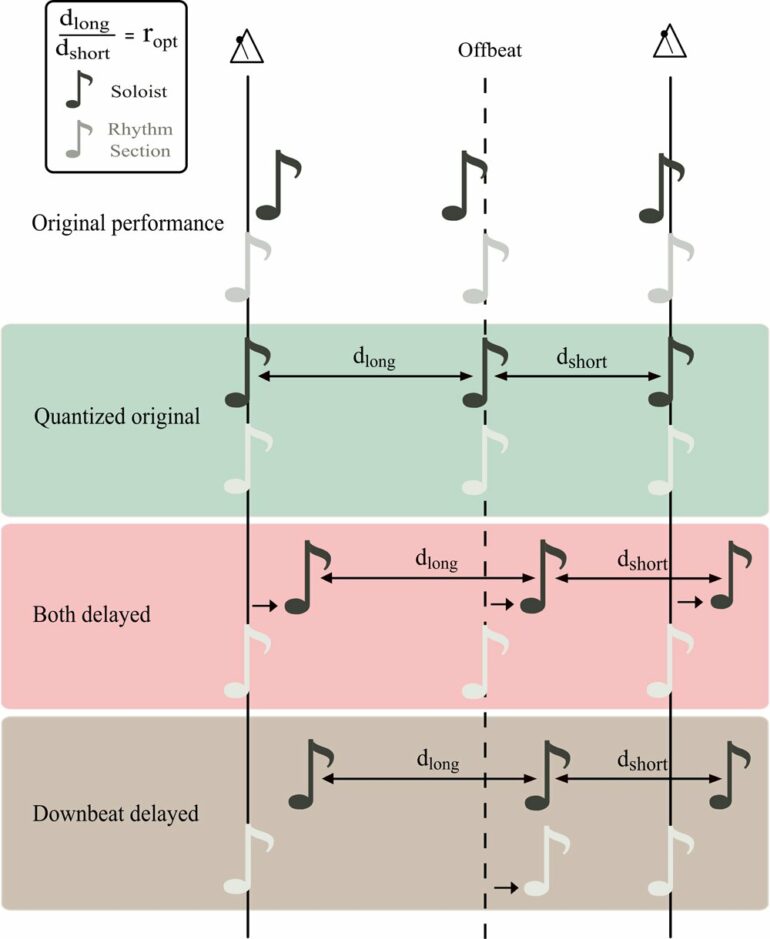Jazz must swing—jazz musicians agree on that. However, even 100 years after the beginnings of jazz, it is still unclear what exactly constitutes the swing feel. With a sophisticated experiment and data analyses on more than 450 well-known jazz solos, physicists from the Max Planck Institute for Dynamics and Self-Organization (MPI-DS) together with psychologists from the University of Göttingen have unraveled a secret of swing.
In their study now published in Communications Physics, they were able to demonstrate that certain systematic deviations in timing are a key component of swing. These microtiming deviations are so small that they are not perceived as such even by professional jazz musicians, who nonetheless are using them unconsciously.
“What is this thing called swing?” Louis Armstrong already asked in one of his songs. The term was introduced by jazz musicians to denote a specific performance style they considered essential for jazz. Although the swing feel is one of the most important characteristics of jazz, for a long time it was believed that swing could be felt but not explained. Merely the alternation of eighth notes played at unequal lengths, so-called “downbeats” and “offbeats,” are an easily perceivable component of swing. But this feature alone is not sufficient for swing, as jazz musicians know; it can even be produced easily by a computer. So the question arises: what other components make up swing?
Minute temporal deviations as a cause of swing?
Since the 1980s, scientists have claimed that the swing feel is created by minute timing deviations between different instruments. In contrast, other researchers emphasized the necessity of rhythmic precision. To address this question, the research team designed an experiment in which they manipulated the timing in original recordings of pianists in various ways on the computer.
These manipulated recordings were then used to measure the intensity of the swing feel as rated by professional and semi-professional jazz musicians. In a first study, the team was able to demonstrate that involuntary random timing deviations do not contribute to the swing feel, and can even impair it.
Downbeat delays are crucial
In their new study, the scientists now investigated the influence of various systematic deviations between soloists and rhythm section on the swing feel. They found, for example, that uniformly delaying downbeats as well as offbeats of the soloists did not enhance the swing feel. In contrast, it was significantly enhanced when only the downbeats were delayed uniformly by about 30 milliseconds, while the soloist’s offbeats remained in sync with the rhythm section. In this way, downbeat delays were shown to be a cause of the swing feel.
“Professional jazz musicians whom we asked explicitly at the end of the experiment could perceive a pleasant friction between soloist and rhythm section, but were amazed that they could not determine the nature of the effect,” explains Theo Geisel, initiator of the project and emeritus director at MPI-DS. “The question thus arose whether the effect produced by delayed downbeats is used by jazz musicians at all,” continue Thorsten Albrecht and York Hagmayer, psychologists from the University of Göttingen involved in the study.
To clarify this question, the team performed data analyses on more than 450 solos performed by well-known jazz musicians. It turned out that downbeat delays were indeed used in almost all cases. “Apparently this subtle method of creating the swing feel is used only unconsciously by jazz musicians; they were not aware of the effect,” summarizes Theo Geisel.
A century after musicians like Louis Armstrong and Duke Ellington took the stage, it is now becoming clearer what exactly constitutes the swing feel.
More information:
Corentin Nelias et al, Downbeat delays are a key component of swing in jazz, Communications Physics (2022). DOI: 10.1038/s42005-022-00995-z
Provided by
Max-Planck-Institut für Dynamik und Selbstorganisation
Citation:
The secret of swing, addressed in the lab (2022, October 7)



